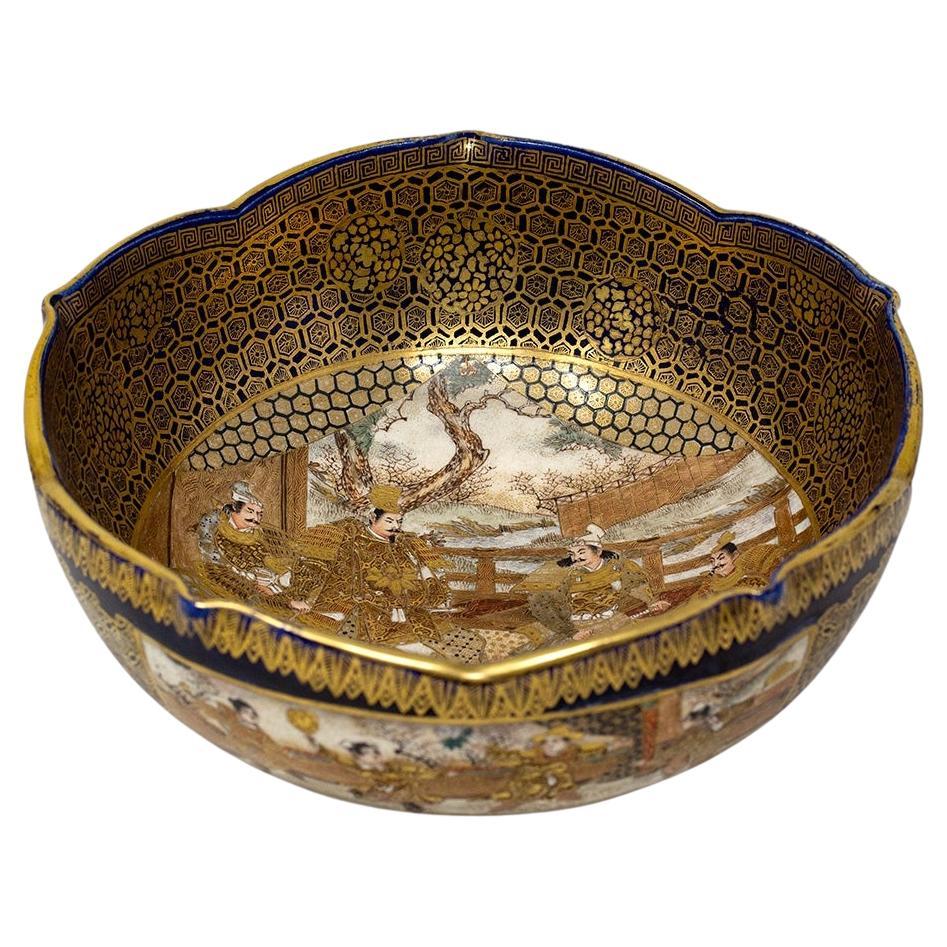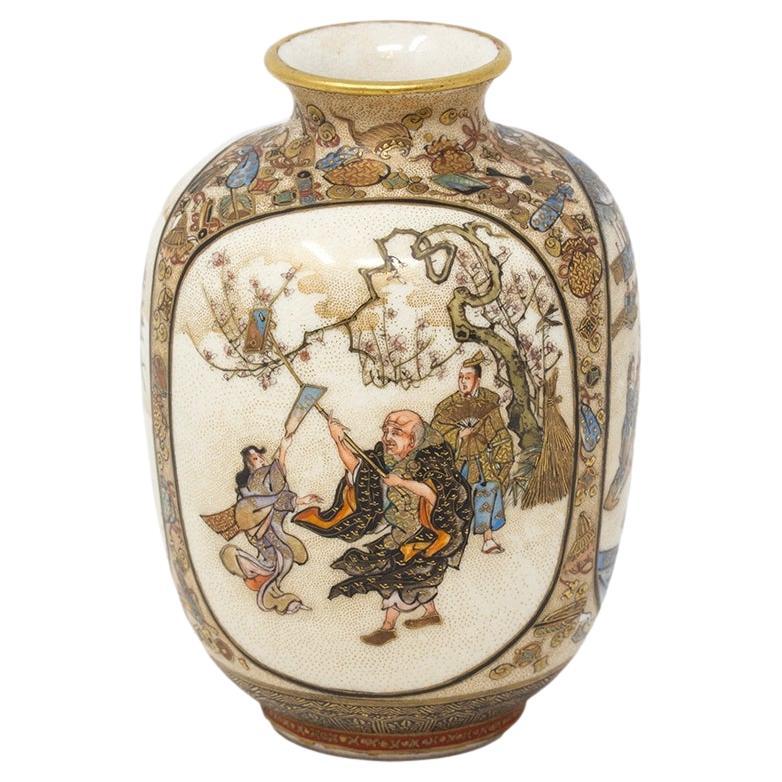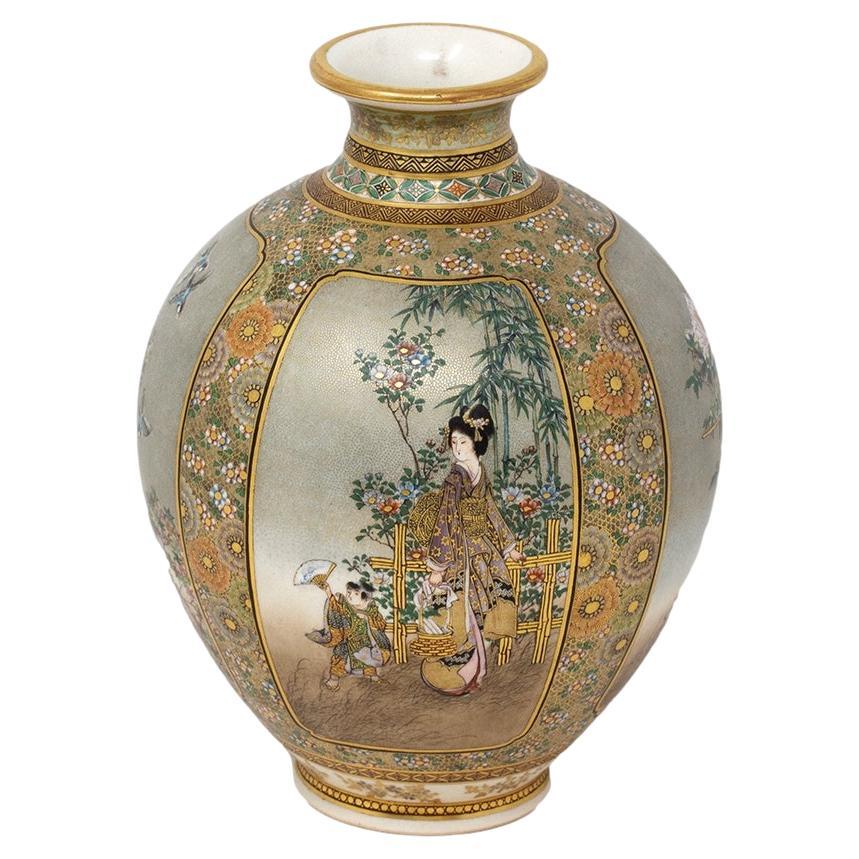Items Similar to Japanese Meiji Period Satsuma Koro
Want more images or videos?
Request additional images or videos from the seller
1 of 21
Japanese Meiji Period Satsuma Koro
About the Item
Bulbous Form
From our Japanese collection, we are delighted to offer this Japanese Meiji Period Satsuma Koro. The Japanese Satsuma Koro of rounded form neatly potted with a small top hat lid surmounted by a ball finial. The exterior of the Koro is decorated extensively with four scenes featuring various figures in different pursuits framed with pinstriped cartouche borders. Each scene overlaps the other with fan motifs alongside butterflies and lappets of decoration to the top and bottom rims. The base of the vase bears a faint remnants of the makers signature which has now become illegible. The Japanese Satsuma Koro dates to the turn of the 20th century during the Meiji Period (1868-1912) circa 1905.
Koro a squat broad-mouthed usually covered jar used mostly as an incense burner.
Meiji Period was an era of Japanese history that spanned from 1868 to 1912. It was the first half of the Empire of Japan, when the Japanese people began to build a paradigm of a modern, industrialised nation state and emergent great power, influenced by Western countries and aesthetics. As a result of radically different ideas, the changes to Japan were profound and it affected the social structure, politics, economy, military, and foreign relations across the board. The period corresponded to the reign of Emperor Meiji and was preceded by the Keio era and was succeeded by the Taisho era.
Cultural Art during the Meiji Period was of particular interest to the government and they overhauled the art export market which in turn promoted Japanese arts via various world’s fairs, beginning in Vienna at the world fair in 1873. The government heavily funded the fairs and took an active role organising how Japan’s culture was presented to the world including creating a semi-public company named Kiritsu Kosho Kaisha (First Industrial Manufacturing Company). The Kiritsu Kosho Kaisha was used to promote and commercialise exports of Japanese art and established the Hakurankai Jimukyoku (Exhibition Bureau) to maintain quality standards. For the 1876 Centennial International Exhibition in Philadelphia, the Japanese government created a Centennial Office and sent a special envoy to secure space for the 30,000 items that would be displayed. The Imperial Household also took an active interest in arts and crafts, commissioning works by select artists to be given as gifts for foreign dignitaries further emphasising the high quality and importance of Japanese art. Just before the end of the 19th century in 1890, the Teishitsu Gigeiin (Artist to the Imperial Household) system was created to recognise distinguished artists. These artists were selected for their exceptionally high quality wares and talent in their own industry. Over a period of 54 years Seventy artists were appointed, amongst these were ceramicist Makuzu Kozan and cloisonné enamel artist Namikawa Yasuyuki.
Satsuma ware is a type of earthenware pottery originating from the Satsuma province in Southern Kyushu, Japan’s third largest island.
- Similar to:Kinkozan (Manufacturer)
- Dimensions:Height: 7 in (17.78 cm)Diameter: 8 in (20.32 cm)
- Style:Meiji (Of the Period)
- Materials and Techniques:
- Place of Origin:
- Period:1900-1909
- Date of Manufacture:Circa 1905
- Condition:Wear consistent with age and use.
- Seller Location:Newark, GB
- Reference Number:
About the Seller
5.0
Vetted Seller
These experienced sellers undergo a comprehensive evaluation by our team of in-house experts.
Established in 2019
1stDibs seller since 2022
18 sales on 1stDibs
Typical response time: 1 hour
- ShippingRetrieving quote...Ships From: Newark, United Kingdom
- Return PolicyA return for this item may be initiated within 14 days of delivery.
More From This SellerView All
- Antique Japanese Meiji Period Satsuma Koro KizanLocated in Newark, EnglandMeiji Period (1868-1912) From our Japanese collection, we are pleased to offer this Antique Japanese Meiji Period Satsuma Koro by Kizan. The Koro of squat bombe form raised upon an...Category
Antique 1890s Japanese Meiji Ceramics
MaterialsCeramic, Earthenware
- Japanese Meiji Period Satsuma Bowl KinkozanBy KinkozanLocated in Newark, EnglandFrom our Japanese collection, we are delighted to offer this Japanese Meiji period Satsuma Bowl by Kinkozan. The earthenware bowl with pinched rim extensively decorated on both the exterior and interior. The bowl with a cobalt blue base glaze decorated to the borders with gilt shippo-tsunagi (linked-cash) with scattered medallion roundells. Around the exterior two elongated scenes are featured, one with boys playing games in a courtyard with the other featuring seated scholars in full dress both with raised enamel decoration. The interior features a central scene with Samurai warriors in training fully armoured with swords in a courtyard with landscapes scenes to the background. The central scene bordered by further stylised shippo-tsunagi type decoration with a greek key rim border. The bowl signed to the base Kinkozan dating to the Meiji Period (1868-1912) circa 1900. Shippo-Tsunagi (linked-cash) or seven treasures, is a traditional Japanese geometric pattern that combines four ellipses in a circle. These ellipses repeat outward to then create more circles, symbolising eternal peace and happiness. Kinkozan the Kinkozan family have been associated with pottery dating back to 1645. They went on to become the largest producer of Satsuma ware by one individual company, from the end of the 19th century until 1927 after which the factory closed. By the 1850s Kobayashi Sobei (1824-84), Kinkozan Sobei...Category
Antique Early 1900s Japanese Meiji Ceramics
MaterialsCeramic, Earthenware, Pottery, Faux Leather
- Japanese Hand Painted Meiji Period Satsuma VaseBy KinkozanLocated in Newark, EnglandSquat Bulbous Form From our Japanese collection, we are delighted to offer this Japanese Meiji Period Satsuma Vase. The Satsuma vase of squat bulbous form with a tightly pinched nec...Category
Antique Late 19th Century Japanese Meiji Ceramics
MaterialsCeramic, Earthenware, Pottery
- Japanese Meiji Period Satsuma Plate by KinkozanBy KinkozanLocated in Newark, EnglandPainted with Two Snipe Amongst Iris From our Japanese collection, we are delighted to offer this Japanese Meiji Period Satsuma Plate by Kinkozan. The Satsuma Plate is extensively de...Category
Antique Late 19th Century Japanese Meiji Ceramics
MaterialsCeramic, Earthenware, Pottery
- Japanese Meiji Period Satsuma Vase by KinkozanBy KinkozanLocated in Newark, EnglandThe vase is potted in globular form with a tightly pinched neck and rolled top rim beautifully decorated with four highly detailed individual panelled scenes. The first a Geisha bari...Category
Antique Late 19th Century Japanese Meiji Ceramics
MaterialsCeramic, Earthenware, Pottery
- Japanese Meiji Period Satsuma Bowl Signed SuizanLocated in Newark, EnglandJapanese Meiji period satsuma scalloped shaped bowl. The bowl of beautiful form with gilt pin-striping and dotting to the accented areas. The exterior decorated with multiple fish swimming around the outside with small flower sprays between. To the inside a painted netting covers the bowl with butterflies and further floral sprays. The centre decorated with representations of each of the woodcut prints from Hiroshige's Tokaido gojusan tsugi (53 Stations of the Tokaido Road). To the base a stylised cartouche signature within an oval for Suizan. This Japanese satsuma bowl...Category
Antique Late 19th Century Japanese Meiji Ceramics
MaterialsCeramic, Earthenware, Pottery
You May Also Like
- Antique Japanese Satsuma Mini Koro Incense Burner Japan Meiji PeriodLocated in Amsterdam, Noord HollandDescription: Fabulous Japanese Satsuma koros. Small red marks on both lid and koro, 19th century. Condition: Overall condition perfect. Size: 85 x 80mm H x D Period: Meiji P...Category
Antique 19th Century Japanese Meiji Ceramics
MaterialsEarthenware
- Kinkozan, Japanese Satsuma Vase, Meiji PeriodBy KinkozanLocated in West Palm Beach, FLKinkozan, Japanese Satsuma vase, Meiji Period (1868-1912) Of baluster form with an elongated neck decorated in polychrome enamels and gilt on a clear crackle glaze in an Art-Nouvea...Category
20th Century Ceramics
MaterialsCeramic
- Japanese Satsuma Incense Burner, Koro, Meiji Period, Late 19th Century, JapanLocated in Austin, TXA fine and elegant Japanese Satsuma tripod incense burner, koro, with pierced metal lid, signed Eizan (?) Meiji Period, late 19th century, Japan. The koro, or censer, features a stoneware body of slightly compressed globular form, supported on three short and squat legs. The wide mouth with a recessed metal rim, and topped by an openwork metal lid topped with overlapping chrysanthemum blossoms of silver repousse. The body of the koro finely painted with fan shaped cartouches. The fans in the foreground with sprays of blossoming chrysanthemum. The fans in the background with intricate geometric brocade designs. The shoulder of the incense burner decorated with cartouches formed as stylized chrysanthemum petals, and intricately decorated with geometric and floral brocade designs. The painting finely done in raised gilt and polychrome enamels, including the highly desirable gosu blue...Category
Antique Late 19th Century Japanese Meiji Ceramics
MaterialsSilver, Metal
- Japanese Satsuma Tripod Censer, Koro, Meiji period, Early 20th Century, JapanLocated in Austin, TXA small and finely decorated Japanese Satsuma tripod incense burner (koro), signed Kyozan, Meiji period, circa 1900, Japan. The censer, koro, with a compressed body supported by t...Category
Antique Early 1900s Japanese Meiji Ceramics
MaterialsStoneware
- Miniature Antique Japanese Satsuma Pottery Censer or KoroBy KinkozanLocated in Philadelphia, PAA fine antique Japanese Satsuma pottery incense burner. With a cream ground and an extensively gilt exterior. There are numerous cartouches around the censer with each having a un...Category
Early 20th Century Meiji Ceramics
MaterialsPottery
- Japanese Satsuma Cylindrical Koro and Cover, Signed Gyokuzan, Meiji PeriodLocated in West Palm Beach, FLA Japanese Satsuma cylindrical koro and cover, signed Gyokuzan, Meiji period (1868-1912) Raised on three supports, painted and gilt with a continuous scene of ladies and children p...Category
Antique 19th Century Ceramics
MaterialsCeramic
Recently Viewed
View AllMore Ways To Browse
Korean Chawan
Industrial Leather And Steel Adjustable Stools
Sitters Chair
Jewelry Box With Glass
White Glazed Pot
Laminated Doors
Pair Of Italian Drawings
Elegant Old Chandeliers
Vintage France Club
Regency Ormolu
Dining Armchair Blue
Handmade Custom Glass Chandelier
Brazilian Midcentury Modern Lounge Chair
Galley Table
Mackintosh Art
Stool To Sit On
Off White Side Chair
Expansion Watch





